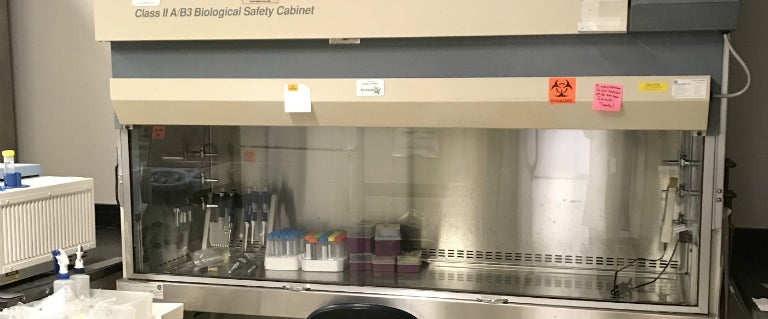Biosafety Cabinet

A biosafety cabinet (BSC), also called a biological safety cabinet, is an enclosed or semi-enclosed, semi-ventilated laboratory workspace for safely working with materials contaminated with (or potentially contaminated with) pathogens requiring a defined biosafety level. The primary purpose of a BSC is to protect the laboratory worker and the surrounding environment from pathogens. All exhaust air is HEPA-filtered as it exits the biosafety cabinet, removing harmful bacteria and viruses. Most classes of BSCs have a secondary purpose to maintain the sterility of the materials inside, such as the study and growth of cell/tissue cultures from a variety of sources.
Types of BSCs:
There are three types of BSCs (class I, II, and II). Open-fronted Class I and Class II BSCs are partial containment devices that are designed to provide protection to laboratory personnel and the environment when used in combination with good laboratory technique.
The Class I BSC is suitable for work involving low-to-moderate risk agents where there is a need for containment, but not for product protection. These BSC’s are mostly used to enclose lab equipment such as centrifuges or for procedures that may generate aerosols such as tissue homogenation.
The Class II BSC protects the material being manipulated inside the cabinet (e.g., cell cultures) from external contamination. It meets requirements to protect personnel, the environment, and the product. The two basic types of Class II BSCs are Type A and Type B. The major differences between the two types is the percent of air that is exhausted vs recirculated and the manner in which exhaust air is removed from the work area.
The gas-tight Class III BSC, or glove box, provides the highest attainable level of protection to personnel, the environment, and the product. It is the only unit that provides a total physical barrier between the product and personnel. It is used with high-risk biological agents and when absolute containment of highly infectious or hazardous material is required.
The Laminar Flow Bench (LFB), also referred to as a clean bench, provides an aseptic environment by passing HEPA filtered air across the work surface. It is important to note that horizontal laminar flow benches must not be used for work with biohazardous or chemically hazardous materials. These units provide product protection only by ensuring the product is exposed to HEPA-filtered air. They do not provide protection to personnel or the ambient environment.
Maintenance, Service, and Calibration
All BSC’s need to be inspected and maintained on a regular schedule. During this certification check, the airflow and the filter capacities are verified. The filters have a limited lifespan – determined by the air quality within the laboratory space and the amount of particles and aerosols generated inside the BSC’ work zone. As these filters load, the internal fan is required to do more work to push/pull the same volume of air through them. If the flow drops below desired performance an audio and visual alarm will alert the operator. Filter changing is limited to trained persons as the filter is potentially contaminated.
BSC’s are required to be re-certified on an annual basis by a certified vendor. Contact EH&S at 7-4712 for information about qualified vendors.
Moving a BSC:
Biosafety Cabinets that will be disposed of or relocated to another lab space or off-campus must be decontaminated by a certified vendor prior to moving. After decontamination, the vendor will provide a certificate of decontamination that must be submitted to EH&S for relocation approval.
When receiving a cabinet from another institution, EHS must be provided a certificate of decontamination from the institution for approval. This must occur prior to any moving arrangements.
